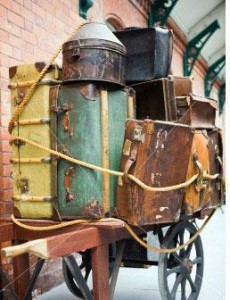 Fear with a capital F has been bred deep into our neurons since man first walked the earth. Neurobiologists call it the “negativity bias” of the brain. For most of history, our brains needed to fear a stick far more than we needed to enjoy a carrot. “If you fail to avoid a stick in the Serengeti today, you’re finished – but if you don’t find a carrot today, you’ll likely be alive to find one tomorrow,” as Dr. Rick Hanson puts it.[FN1]
Fear with a capital F has been bred deep into our neurons since man first walked the earth. Neurobiologists call it the “negativity bias” of the brain. For most of history, our brains needed to fear a stick far more than we needed to enjoy a carrot. “If you fail to avoid a stick in the Serengeti today, you’re finished – but if you don’t find a carrot today, you’ll likely be alive to find one tomorrow,” as Dr. Rick Hanson puts it.[FN1]
It hits me that my trauma is a cosmic joke based on fear: I’m the logical consequence of human evolution. And the numbers are coming in now to show that our failure to respect how our bodies have evolved is the reason 50% of Americans have some degree of Adult Attachment Disorder, childhood ACE trauma, and the resultant dire medical effects.
“This is your Captain speaking from the Butt End of Evolution,” I joked to a friend. “Since we left the caves, the brain has been evolving to develop an ever-more exquisite ability to feel fear. Only the most fearful and anxious of us survived.
“Finally my great-grand parents traveled from London to Cape Town to Canberra to Denver while having 13 children, of whom my grandma was the 12th. How much attachment, attuned face-to-face emotional attention, could grandma have received? Do the math; she couldn’t have gotten much more attention than the 12th piece of luggage. So how much attuned parenting could she have given my mother?
“By that point humans had evolved to be so fearful and anxious that great-grandma probably treated my grandma like luggage, who treated my mother like luggage, then my mother didn’t even want the luggage; she didn’t want a child, as she made clear to me. So here I am at the Butt End of Evolution: I couldn’t manage to procreate at all, or stay married. I have no children and no family.
“The moral is: if you have a lot of emotional baggage, the reason might be that you, too, were treated like luggage.”
Too depressing? Never fear! There are solutions.
Child Production Failure Rate: 50%
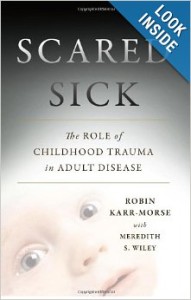 Look: Adam and Eve got perfect parenting, but still had a 50% failure rate in producing good kids. Translation? Babies are very easy to damage, and this problem has been around a long time. But it’s never been acceptable and it’s getting worse.
Look: Adam and Eve got perfect parenting, but still had a 50% failure rate in producing good kids. Translation? Babies are very easy to damage, and this problem has been around a long time. But it’s never been acceptable and it’s getting worse.
Last week I wrote that our society now has a 50% failure rate at producing healthy human children, by many medical, mental, and psychological health yardsticks which show a remarkable correlation.
The Adverse Childhood Experiences (ACE) Study documents that childhood trauma and its consequent serious medical issues affect over 50% of the population of the U.S. and cause the risk factors that underlie the 10 most common causes of death in our country.
The Adult Attachment Interview (AAI), meanwhile, shows that some 50% of Americans are “insecurely attached,” meaning they have some degree of attachment disorder, another form of childhood trauma which may underlie many of the childhood traumas in the ACE Study.
The statistics keep coming. According to “Scared Sick” by Robin Karr-Morse, nearly 50% of Americans have high blood pressure, high cholesterol, or diabetes; one in eight has two of these. Some 68% of adults are over weight and more than one-third are obese, and 26% of adults over 18 suffer from a diagnosable mental disorder. One in three children born in the last five years will develop diabetes. [FN3]
Negativity Bias of the Brain
 Well, what’s at the root of childhood trauma, which seems to be a major cause of all this?
Well, what’s at the root of childhood trauma, which seems to be a major cause of all this?
Fear. We need to understand fear, to reverse this. “Fear has shadowed human life since our species emerged,” says the first sentence of “Scared Sick.”
“Neuroscience tells us the brain has a negativity bias. It’s designed like Velcro for negative events and Teflon for positive ones,” says Dr. Ron Siegel, Phd. “Evolutionarily if our ancestors forgot what they saw the sabre-tooth tiger do, or what happened to someone who got too close to a cliff, they wouldn’t have survived to produce offspring. Our chill, relaxed forerunners all got eaten in the Serengeti before they could become our ancestors. Survivors were those who remembered the bad stuff and were good at jumping when the sabre-tooth tiger showed up.
“Stress-related disorders are a huge health problem today, but most of them don’t kill us before we’re done reproducing,” he concludes, “especially if you go back a few thousand years where people didn’t live beyond 40. Stress-related disorders make us miserable, but they don’t kill us until after 40.” [FN5]
“The velocity of change in our environment and the nature of the fears we face as a consequence has evolved much faster than our biological systems for dealing with them,” “Scared Sick” states. “Americans regularly wake up, work, parent, drive, play, eat, and sleep with the twin offspring of fear—anxiety and depression—holding court in their brains and bodies. This is our shared daily bath: in our homes, on the road, in the workplace. The result? Soaring addiction, anxiety, depression, attention disorders and post-traumatic stress…”
Luggage and Emotional Baggage
Last night, Ancestry.com confirmed my worst fears and then some. I’m the product of four generations of attachment failure. I already had 80% of the story from family by word of mouth. But last night in under an hour online, I found U.S. federal census records that hit me in the gut.
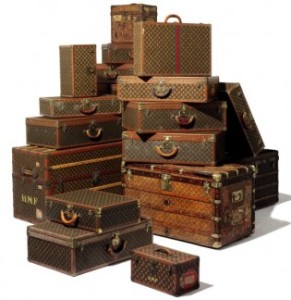 My maternal grandmother’s parents were born in London, according to family lore; Grannie and her sisters my great aunts all reported they had 13 children, of which my grandmother Jennie was the twelfth, born in 1906 in Denver. These relatives also often separately remarked, as though it were totally unrelated and uninteresting, that the family moved from London, England, to Cape Town, South Africa, to Canberra, Australia, to Denver, Colorado, then New York City, during all this.
My maternal grandmother’s parents were born in London, according to family lore; Grannie and her sisters my great aunts all reported they had 13 children, of which my grandmother Jennie was the twelfth, born in 1906 in Denver. These relatives also often separately remarked, as though it were totally unrelated and uninteresting, that the family moved from London, England, to Cape Town, South Africa, to Canberra, Australia, to Denver, Colorado, then New York City, during all this.
In early 2011 I read a quote in a book on attachment disorder which said: “Mothering well doesn’t come naturally. What comes naturally is mothering as you were mothered.” [FN7]
Then I remembered the 13 children and the trans-continental travels, and it hit me that if these reports were true, that my great-grandma –- just by the math –- had been able to give my grandma Jennie about as much attention growing up as one of the traveling suitcases, if she were lucky. That would have left Jennie without mothering skills to pass on to my mother, which made some sense out of why I had never noticed my mother to have been overflowing with motherly affections.
Last night family tales became reality. I learned that Grandma Jennie’s dad, my great-grandfather, was named Maurice and was born in London in 1860; his wife Esther was born in London in 1872.
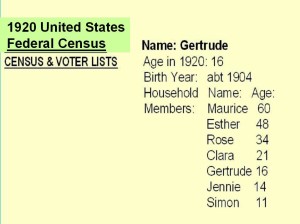 Then I found the 1920 U.S. Federal Census shown here. All of the names of their children listed here, correspond to people I’ve either met or heard about.
Then I found the 1920 U.S. Federal Census shown here. All of the names of their children listed here, correspond to people I’ve either met or heard about.
Plus the 1910 U.S. Federal Census shows Maurice in Colorado where my grandmother Jennie was born; I’ve definitely got the right people.
But here’s the scary thing. The household of Maurice age 60 and Esther age 48, by then in New York City, included Rose age 34, Clara age 21, Gertrude age 16, Jennie age 14, and Simon age 11. Good grief, that means Rose was born in 1886 when her mother Esther was 14! Then Clara was born in 1899, Gertrude in 1904, Jennie in 1906, and Simon in 1909.
I’m shocked just to see such a large family in official records; it brings flesh and blood to real life. How could poor Esther take care of them all? How did she survive herself, did she ever sleep? How did they all survive all that travel? Did they have enough to eat? Did they have any place to sleep? The sheer size of it feels traumatic to me, maybe in my bones.
Plus in 1886 when Rose was born, her dad Maurice was 26. It seems he knocked up Esther at 13 or 14 and absconded with her to South Africa.
And what about the 13-year gap between Rose and Clara? There are only 5 children in this 1920 census out of 13 births reported by numerous people to me in person. Did Rose not marry while her 6 or 8 younger siblings born on either side of Clara left the household, and are thus not shown on this census page? Or did large numbers of the children die in terrible ocean voyages or epidemics like the 1917 influenza?
How did one get from London to Cape Town to Canberra to Denver to New York back then, anyway? For most of human history before 1800, including most of human biology, people didn’t move around. Wikipedia reports fewer than one million immigrants—perhaps as few as 400,000—crossed the Atlantic during the entire 17th and 18th centuries.
But after 1800 we had the spreading use of the steam engine, electricity, railroads, the Gold Rush which developed the continental United States. Now, the new explosion of mobility was a very good thing; it allowed millions to escape tyranny and grinding poverty in Europe. From 1836 to 1914, over 30 million Europeans immigrated to the United States.
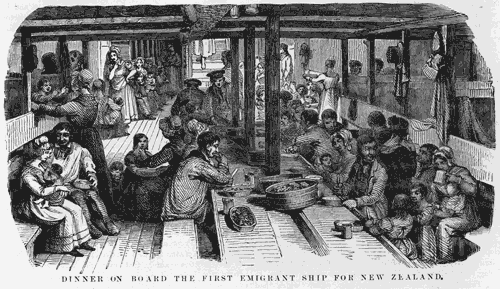 By the end of the 19th century even the poorest could get into the steerage hold of a steamship, shown above, where they all lived like luggage for weeks. The peak year of European immigration was in 1907, when 1,285,349 persons entered the country. By 1910, 13.5 million immigrants were living in the United States. [FN8]
By the end of the 19th century even the poorest could get into the steerage hold of a steamship, shown above, where they all lived like luggage for weeks. The peak year of European immigration was in 1907, when 1,285,349 persons entered the country. By 1910, 13.5 million immigrants were living in the United States. [FN8]
Why? “To better our lives!” That’s why we’ve created these fabulous technologies. Yet we don’t see what living at this faster pace does to our nervous systems and our ability to attune to human beings, person to person. This has only accelerated since 1920, until today society is substituting computers, video games, and other addictions, for yesterday’s simple face-to-face human contact.
We’ve got the “negativity bias” bred into our brains because our chill ancestors got eaten in the Serengeti so only the antsy, anxious ones survived. Then in the industrial revolution we ended up with vastly reduced family time, to where people were treated like luggage.
Today the IT revolution has virtually done away with face time.
But “the primal mood of the human being separated from close connection to other human mammals is fear,” says Dr. Tara Brach. Welcome to the Root Issue of what we’ll have to heal.
Footnotes
FN1 Types of early man are thought to have originated in Africa’s Serengeti plain. Hanson, Rick PhD., “Neurodharma: How to Train the Brain Toward Mindfulness,” webiner series “The New Brain Science: Compelling Insights for State of the Art Practice,” September 28, 2011, www.NICABM.com.
“We’ve got to get rewards, we’ve got to get food, we’ve got to get mates, we’ve got to get shelter – the carrots in evolution. On the other hand, we have to avoid sticks. We have to avoid predators; we have to avoid aggression in our primate band; we have to avoid natural hazards; we have to avoid pain,” Hanson writes.
“So the brain has bias toward scanning for negative information, focusing on it, ignoring any good news, then storing that negative experience very deeply – in just one trial learning. For example, humans and other animals learn much more quickly from pain than from pleasure. To teach a rat to not go down a tunnel, you only have to shock it once. But to train it positively to go down another tunnel that has cheese, you’ve got to send it there a few times before it remembers.
“John Gottman’s findings show that on the average it takes about five positive interactions in a couple to make up for a single negative one. Negative interactions are five times as powerful as positive interactions. Seligman found it’s easy to train dogs, and by extension, humans, in helplessness. It only takes a handful of trials to train a dog into a sense of futility and depression. But it takes many, dozens and dozens, sometimes over a hundred trials to re-train that dog to see it can do something about it.”
FN3 Karr-Morse, Robin, Wiley, Meredith, “Scared Sick,” Penguin Basic Books, 2012; Introduction, p.xiv
FN4 White, Martha C., “The Real Reason New College Grads Can’t Get Hired,” Time, November 10, 2013 http://business.time.com/2013/11/10/the-real-reason-new-college-grads-cant-get-hired/#ixzz2kgHn3dNZ
FN5 Siegel, Ronald D. “The Neurobiology of Mindfulness: Clinical Applications ,” Webiner series “The New Brain Science: Compelling Insights for State of the Art Practice,” October 5, 2011, www.NICABM.com. See also his seminal work:
Germer, Christopher K., Siegel, Ronald D., editors, “Mindfulness and Psychotherapy,” Guilford Press, 2005
FN 6 Perry, Bruce, MD, PhD, “Born for Love: The Effects of Empathy on the Developing Brain,” speech to Annual Interpersonal Neurobiology Conference “How People Change: Relationship & Neuroplasticity in Psychotherapy,” UCLA Extension, Los Angeles, March 8, 2013; Bruce D. Perry and Erin P. Hambrick, “The Neurosequential Model of Therapeutics,” Reclaiming Children and Youth Magazine, Fall 2008 vol 17. nr 3, www.reclaiming.com, (UCLA handout); Perry, Bruce, “Overview of Neuro-sequential Model of Therapeutics (NMT),” article on www.childtrauma.org, 2010
FN7 Verrier, Nancy, PhD, “Coming Home to Self: The Adopted Child Grows Up,” self-published, Lafayette, CA, 1993
FN8 Wilson, John, ‘The voyage out – Life on board’, Te Ara – the Encyclopedia of New Zealand, updated 15-Nov-12 http://www.TeAra.govt.nz/en/artwork/4237/steerage-passengers-eating-dinner
FN8 Brach,Tara, PhD, “The Mindful Path to Radical Acceptance,” Webiner series “The New Brain Science: Compelling Insights for State of the Art Practice,” October 25, 2011, www.NICABM.com.
This is a blog done as a study for Kathy’s forthcoming book “DON’T TRY THIS AT HOME: The Silent Epidemic of Attachment Disorder—How I accidentally regressed myself back to infancy and healed it all.” Watch for her posts each Friday, as she explores her journey of recovery by learning the hard way about Attachment Disorder in adults, adult Attachment Theory, and the Adult Attachment Interview.
![]()



My family history is so similar. With all the immigrant families in the US, I wonder how many Americans have these traumatic family histories? My grandpa’s parents on my dad’s side came from Germany before WWI. Grandpa was the last of 11 boys; all were sent to WWI except him; only one of his brother’s came back alive.
On mom’s side her dad was an identical twin, immigrants from Belgium, whose twin died in the Depression; very traumatizing. Mom’s mother, due to the Depression, had little food as a child. Later she gave birth to twins who died, then a daughter who got polio, then a son with a heart defect that required surgery as a boy — and then she had my mother, the youngest. Mom told me that as a child she was never seen. So of course she never saw me. And I saw that Grandma did not like my mom and she let my mom know that she didn’t like any kids from my dad….plus my mom suffered child abuse from an uncle. It just gets passed down in families…
Pingback: Excommunication Blues | "Don't Try This at Home"
Brilliant weaving of your generations upon generations to answer the “Why” of your fear-based beginnings…… and life.
You guys had the right idea last time I was there:
“We don’t rush dinner; we dine,” you said. You all sit down together with flowers, candles and good-old-fashioned eye contact, no electronic devices. I love it.
Your sharing makes total sense–thank you. Illumination is taking leaps and bounds in that old constant question “why” do I feel this way! Keep going-you are helping and healing many. So glad I met you Looking forward to getting together again. Betty
Thank you, that feels very good that you’d comment in public!
Didn’t want to drag anyone else into this but some family tree, yikes… Whu Nhu?
You have a family and it is me